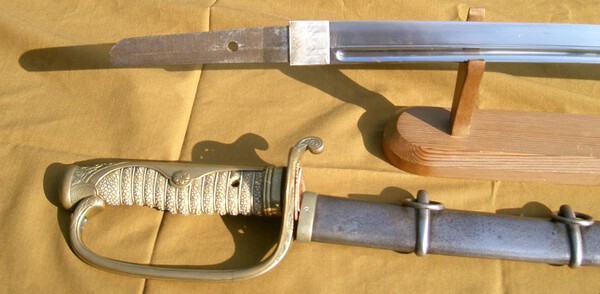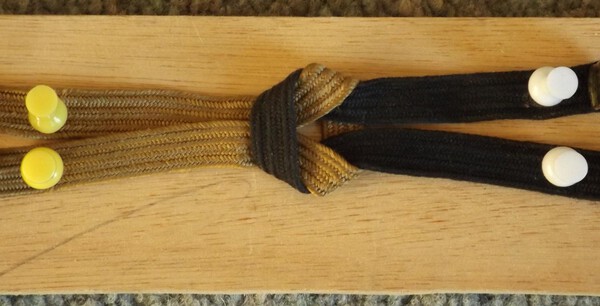
Geraint
Members-
Posts
2,992 -
Joined
-
Last visited
-
Days Won
9
Content Type
Profiles
Forums
Events
Store
Downloads
Gallery
Everything posted by Geraint
-
-
Dear Brian. I can see everything available from All Sellers but just the one thing from Matt's listings. Not to worry, if everyone else can see them that's fine. All the best.
-
Hi Matthew. All I get from the link is one tsuka, is that just me? All the best.
-
Dear John. There is a thread on here regarding a Shinshinto smith named Seishinshi Masayuki who seems to have specialised in forging small tanto with the type of hada that yours is displaying, almost certainly produced by mixing steels in the fairly coarse hada. If you are not already a member of the Token Society or Northern Token Society can I suggest that you go along to one of their meetings where others will see tell you what they think. All the best.
-
Dear Mike. Nice find! The blade is in much better condition than many that appear here and the nakago is in good condition. A militarised civilian wakizashi, as I am sure you know. It has possibly had a rewrap as the ito folds are all in one direction rather than alternating, no harm. I would be tempted to get that other seppa foiled and leave it as is. Enjoy! All the best.
-
Dear Denis. Not so much hada as had! Ah! All the best.
-
Dear Jon. What do you think about the shape and orientation of the kodzuka hitsu? Oh, and how thick is this one? All the best.
-
Dear Jon. Guessing is great but how about telling us why you arrived at that conclusion? All the best.
-
Kawachi Daijo/ Kuni Sada sword - opinions please
Geraint replied to Dean1981's topic in Military Swords of Japan
Dear Dean. This mei is unusual in that the character for sada is not the one expected. Check out this link for information, https://nihontoantiques.com/project/name-sword-fss-795/ Apparently this smith is ranked josaku so not that great, not to be confused with other more famous Kunisada. If it is priced in dollars then expect some extra coin getting it to you and as it's out of polish then you are looking at several hundred to put it in order. You don't mention the length but it looks like a wakizashi. All in all I would take Ray's advice. All the best. -
Dear Darius. First of all please add your name to your posts on NMB as we all do. I cannot comment on the question regarding Emishi koshirae but the fittings you describe on tachi tsuka are called tawara byo, usually described as rivets in the shape of rice bails. They would not be fitted to a tsuka which was wrapped but are common in unwrapped style. The menuki like ornaments on saya are saya kanagu and are only ever fitted to the outward side of the saya as worn. Looking forward to someone answering the last of the three questions. All the best.
-
Dear Don. The first image in your latest post shows what looks like higaki yasurime and with the hamon this suggest a Mino den tanto. The mounts are pressed brass and are a fairly common late Edo tourist rig. Most of the time the blades found in these mounts are of no consequence but sometimes something slips through. Go carefully, anyone near you who could take a look for you? All the best.
-
Dear Carl. Always interested in this line of smiths, any chance of some images o the rest of the sword? All the best.
-
Dear Margaret. Please add your name to your post as we all do here. The first with the black scabbard is a Kaigunto or Naval sword from WWII, the other with the brown scabbard is a Shingunto or Army sword, also from WWII. The Kaigunto has an anchor stamp and is made from rustless steel. Both are wartime swords in very good condition. Do they have a family history? All the best.
-
Orikaeshi-mei — needle hole?
Geraint replied to RichardP's topic in General Nihonto Related Discussion
Dear Dave. There is so much information on that site, isn't there? My only addition is that there should be a vertical line joining both edges of the new nakago jiri on the third diagram down. All the best. -
Dear Kirill. Forgive me, I am unable to work out whether you are agreeing with Jean or contradicting him. All the best.
-
Orikaeshi-mei — needle hole?
Geraint replied to RichardP's topic in General Nihonto Related Discussion
Dear Richard. So you are shortening a nakago and wish to preserve the mei. You carefully file down the excess nakago to leave a thin strip of metal that carries the mei and you chase out a corresponding groove into which this will fit. Now all you have to do is bend the strip through 180 degrees and make it fit the groove. You can't really dress the end with a hammer to close it firmly so you fold the strip of metal with the mei over and push it into the groove you have prepared. You fold the metal and it forms a radius which does not quite match the squared end of the nakago that you have filed leaving a very small gap that should be clearly visible running from mune to ha. Not perhaps needle shaped but non the less visible. This is a way of discerning that the orikaeshi mei has been done properly and that a mei cut from a completely different sword has not been used. If the mei is a continuous strip of metal then is was originally part of the nakago and hence the small hole. If it has been cut from a different sword and added to this one then you might not see it. Hope that helps. All the best. -
Dear Ken. This is a nice result and the sword looks good, koshirae (Mounting) subdued but very attractive. I think you can ignore the cord. The tsuba (Guard) is of a type usually found on tachi (Long swords carried edge down) with the two extra large seppa (Washers). As it stands it might be called a handachi koshirae, (Half tachi). Muromachi is a period, basically 1400 to 1600 though those dates are not precise but easy to look up. By the end of this period many swords were being made, some in quite a hurry and so are less well regarded by collectors. This does not necessarily apply to your sword. How this survived in a theatre props store without being tarted up or damaged is almost beyond belief. Perhaps they felt it was a bit too realistic to use. All in all a very nice find and certainly something to hang onto, I would if it were mine. Enjoy! All the best.
-
Dear Peter. Please forgive what might be a very long answer to a very short question. The 1993 exhibition, "The Beauty of Shinsakuto" , featured quite a number of blades by some very excellent smiths. A significant proportion were described as challenges to specific named and well known blades, in other words utsushi mono. The exhibition was brought to the UK under the auspices of the Token Society and it was an immense pleasure to be able to examine the blades in hand. Many had the nakago copied faithfully, even o-suriage with many mekugi ana, which I found a little odd at the time. Naotane, renowned for mastering all five of the Gokaden, may have done the same so that specific nakago sori would be related to the blade he was challenging and thus not of itself a kantei point for him as the maker. His blades always seem to have a very well shaped nakago in relation to the overall sugata with appropriate sori for the shape and size of the blade. Thank you for the question, I have enjoyed looking at his work. All the best.
-
-
Dear Steve. Your wakizashi appears to be by Hishu ju Hirosada. Have a look here for more information. http://www.militaria.co.za/nmb/topic/17848-wakizashi-signed-hishu-ju-hirosada/ All the best.
-
Dear Steff. You can sure pick 'em! Managed to find one image, (In Markus Sesko, Encyclopedia of Japanese Swords), and did a mock up of the knot to show how it works. It is not something I have ever seen. What makes you so keen to try this wrap? Hope this helps. All the best.
-
Dear Phil. Well, photo 6, of the whole koshirae is the most revealing. Kodzuka appears to be pressed brass with a hole in it that suggests it might once have been a piece of cutlery, the urugawara in the saya has been broken or cut to suit the kodzuka, tsuba is way out of alignment as is the tsuka. I can't tell much from your images about the tsuba. How many seppa does it have? I quite like the fuchi kashira, not sure about the menuki, tap them with a finger nail and see if you can get a sense of how solid they are; a thin high sound might confirm that they also are pressed brass. All in all I would say this is a bitsa, as in, "Bits a this an bits a that". However you have the sword in hand and can judge the fit of the blade to saya and tsuka, you can also remove the fuchi to see if any packing or other adjustment has been done. My guess would be that blade and saya belong together and the rest has been added to 'complete' the sword. All the best.
-
Dear Ken. I was about to say that a sword bent and then straightened = shinae but having checked I discover that it is not so simple. See here, http://www.ksky.ne.jp/~sumie99/flaws.html I had not realised that the transverse cracks caused by poor work in the steel were also called shinae. However I do not think that either of these cases apply to the sword posted. All the best.
-
Hi Scott and welcome. Have to agree with the advice you have been given. In addition to the suggestion to buy some books think of joining the Token Society of GB or the Northern Token Society or both. Get to meet some people and see some swords. It's really tempting to jump right in but a little patience now will see you right in the future. All the best.




